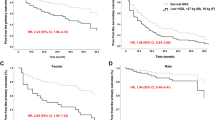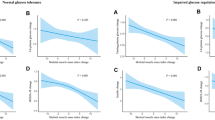Abstract
Aims
The aim of the current study was to investigate the association of type 2 diabetes (T2D) and insulin treatment with changes in muscle mass, muscle strength, and physical performance in older adults.
Methods
In 731 participants of the population-based KORA-Age study aged 74.6 ± 6.2 years (T2D: n = 118; insulin treatment: n = 20), skeletal muscle index (SMI [kg/m2]), hand grip strength (GS [kg]), and a timed up and go test (TUG [s]) were performed at baseline and after a follow-up time of 3 years. The association of T2D and insulin therapy with changes in muscle parameters was analyzed using linear regression models.
Results
After adjustment for sex, age, BMI, physical activity, smoking, and multimorbidity, T2D was associated with the change in SMI during follow-up (β − 0.1 (95% CI − 0.3 to − 0.02) kg/m2; p = 0.02), but not with a change in GS (β − 0.9 (95% CI − 1.9 to 0.04) kg) or TUG (β − 0.1 (95% CI − 0.7 to 0.5) s). Insulin therapy was positively associated with change in SMI (β 0.6 (95% CI 0.3–0.9) kg/m2; p = 0.001), but not in GS (β − 1.6 (95% CI − 4.1 to 0.8) kg) or TUG (β 1.6 (95% CI − 0.2–3.4) s) in comparison with treatment with oral anti-diabetic medication alone.
Conclusions
Participants with T2D showed an accelerated decline in muscle mass compared to non-diabetic participants. Insulin therapy was associated with preserved muscle mass, but not muscle function parameters, indicating a discrepancy between muscle mass and function in this high-risk population.
Similar content being viewed by others
References
Bianchi L, Volpato S (2016) Muscle dysfunction in type 2 diabetes: a major threat to patient‘s mobility and independence. Acta Diabetol 53:879–889. https://doi.org/10.1007/s00592-016-0880-y
Phielix E, Schrauwen-Hinderling VB, Mensink M et al (2008) Lower intrinsic ADP-stimulated mitochondrial respiration underlies in vivo mitochondrial dysfunction in muscle of male type 2 diabetic patients. Diabetes 57:2943–2949. https://doi.org/10.2337/db08-0391
Andreassen CS, Jakobsen J, Andersen H (2006) Muscle weakness: a progressive late complication in diabetic distal symmetric polyneuropathy. Diabetes 55:806–812. https://doi.org/10.2337/diabetes.55.03.06.db05-1237
Scott D, de Courten B, Ebeling PR (2016) Sarcopenia: a potential cause and consequence of type 2 diabetes in Australia’s ageing population? Med J Aust 205:329–333
Kang S, Lim GE, Kim YK, et al (2017) Association between Sarcopenic Obesity and Metabolic Syndrome in Postmenopausal Women : A Cross-sectional Study Based on the Korean National Health and Nutritional Examination Surveys from 2008 to 2011. 9–14
Herder C, Karakas M, Koenig W (2011) Biomarkers for the prediction of type 2 diabetes and cardiovascular disease. Clin Pharmacol Ther 90:52–66. https://doi.org/10.1038/clpt.2011.93
Mavros Y, Kay S, Anderberg KA et al (2013) Changes in insulin resistance and HbA1c Are related to exercise-mediated changes in body composition in older adults with Type 2 diabetes: interim outcomes from the GREAT2DO trial. Diabetes Care 36:2372–2379. https://doi.org/10.2337/dc12-2196
Kalyani RR, Metter EJ, Ramachandran R et al (2012) Glucose and insulin measurements from the oral glucose tolerance test and relationship to muscle mass. J Gerontol A Biol Sci Med Sci 67:74–81. https://doi.org/10.1093/gerona/glr022
Koo BK, Roh E, Yang YS, Moon MK (2016) Difference between old and young adults in contribution of β-cell function and sarcopenia in developing diabetes mellitus. J Diabetes Investig 7:233–240. https://doi.org/10.1111/jdi.12392
Stangl MK, Böcker W, Chubanov V et al (2019) Sarcopenia - endocrinological and neurological aspects. Exp Clin Endocrinol Diabetes 127:8–22. https://doi.org/10.1055/a-0672-1007
Mesinovic J, Zengin A, De Courten B et al (2019) Sarcopenia and type 2 diabetes mellitus: a bidirectional relationship. Diabetes Metab Syndr Obes Targets Ther 12:1057–1072. https://doi.org/10.2147/dmso.s186600
Dimitriadis G, Mitrou P, Lambadiari V et al (2011) Insulin effects in muscle and adipose tissue. Diabetes Res Clin Pract 93:S52–S59. https://doi.org/10.1016/S0168-8227(11)70014-6
Cetrone M, Mele A, Tricarico D (2014) Effects of the antidiabetic drugs on the age-related atrophy and sarcopenia associated with diabetes type II. Curr Diabetes Rev 10:231–237. https://doi.org/10.2174/1573399810666140918121022
Peters A, Döring A, Ladwig K-H et al (2011) Multimorbidity and successful aging: the population-based KORA-Age study. Z Gerontol Geriatr 44(Suppl 2):41–54. https://doi.org/10.1007/s00391-011-0245-7
Washburn RA, Zhu W, McAuley E et al (2002) The physical activity scale for individuals with physical disabilities: development and evaluation. Arch Phys Med Rehabil 83:193–200. https://doi.org/10.1053/apmr.2002.27467
Autenrieth CS, Kirchberger I, Heier M et al (2013) Physical activity is inversely associated with multimorbidity in elderly men: results from the KORA-Age Augsburg Study. Prev Med (Baltim) 57:17–19. https://doi.org/10.1016/j.ypmed.2013.02.014
Janssen I, Heymsfield SB, Baumgartner RN, Ross R (2000) Estimation of skeletal muscle mass by bioelectrical impedance analysis. J Appl Physiol 89:465–471. https://doi.org/10.3945/ajcn.115.119925
Kalyani RR, Tra Y, Yeh H-C et al (2013) Quadriceps Strength, Quadriceps Power, and Gait Speed in Older U.S. Adults with Diabetes Mellitus: results from the National Health and Nutrition Examination Survey, 1999-2002. J Am Geriatr Soc 61:769–775. https://doi.org/10.1111/jgs.12204
Volpato S, Bianchi L, Lauretani F et al (2012) Role of muscle mass and muscle quality in the association between diabetes and gait speed. Diabetes Care 35:1672–1679. https://doi.org/10.2337/dc11-2202
Oberbach A, Bossenz Y, Lehmann S et al (2006) Altered Fiber Distribution and Fiber- Specific Glycolytic and Oxidative Enzyme Activity in Skeletal Muscle of Patients With Type 2 Diabetes. Diabetes Care 29:895–900. https://doi.org/10.2337/diacare.29.04.06.dc05-1854
Yoon JW, Ha YC, Kim KM et al (2016) Hyperglycemia is associated with impaired muscle quality in older men with diabetes: the Korean Longitudinal Study on Health and Aging. Diabetes Metab J 40:140–146. https://doi.org/10.4093/dmj.2016.40.2.140
Bouchi R, Fukuda T, Takeuchi T et al (2017) Insulin treatment attenuates decline of muscle mass in Japanese patients with Type 2 diabetes. Calcif Tissue Int. https://doi.org/10.1007/s00223-017-0251-x
Kalyani RR, Metter EJ, Egan J et al (2015) Hyperglycemia predicts persistently lower muscle strength with aging. Diabetes Care 38:82–90. https://doi.org/10.2337/dc14-1166
Rasmussen BB, Fujita S, Wolfe RR et al (2006) Insulin resistance of muscle protein metabolism in aging. FASEB J 20:768–769. https://doi.org/10.1096/fj.05-4607fje
Boettcher M, Machann J, Stefan N et al (2009) Intermuscular adipose tissue (IMAT): association with other adipose tissue compartments and insulin sensitivity. J Magn Reson Imaging 29:1340–1345. https://doi.org/10.1002/jmri.21754
Marcus RL, Addison O, Dibble LE et al (2012) Intramuscular adipose tissue, sarcopenia, and mobility function in older individuals. J Aging Res. https://doi.org/10.1155/2012/629637
Cuthbertson D (2004) Anabolic signaling deficits underlie amino acid resistance of wasting, aging muscle. FASEB J. https://doi.org/10.1096/fj.04-2640fje
Fujita S, Glynn EL, Timmerman KL et al (2009) Supraphysiological hyperinsulinaemia is necessary to stimulate skeletal muscle protein anabolism in older adults: evidence of a true age-related insulin resistance of muscle protein metabolism. Diabetologia 52:1889–1898. https://doi.org/10.1007/s00125-009-1430-8
Pereira S, Marliss EB, Morais JA et al (2008) Insulin resistance of protein metabolism in type 2 diabetes. Diabetes 57:56–63. https://doi.org/10.2337/db07-0887
Wilkes EA, Selby AL, Atherton PJ et al (2009) Blunting of insulin inhibition of proteolysis in legs of older subjects may contribute to age-related sarcopenia. Am J Clin Nutr 90:1343–1350. https://doi.org/10.3945/ajcn.2009.27543
Acknowledgments
We gratefully acknowledge the contribution of all members of field staffs conducting the KORA-Age study and thank all study participants.
Funding
The KORA research platform studies were initiated and financed by the Helmholtz Zentrum München—German Research Center for Environmental Health, which is funded by the German Federal Ministry of Education, Science, Research and Technology and by the State of Bavaria. The KORA-Age project was financed by the German Federal Ministry of Education and Research (BMBF FKZ 01ET0713 and 01ET1003A) as part of the ‘Health in old age’ program.
Author information
Authors and Affiliations
Contributions
Author contributions
Conceptualization was carried out by Barbara Thorand, Annette Peters, Birgit Linkohr, Jochen Seissler, and Michael Drey; Methodology was carried out by Barbara Thorand, Jochen Seissler, Michael Drey, Marietta Rottenkolber, Uta Ferrari, Cornelia Then, and Romy Conzade; Formal analysis and investigation was carried out by Marietta Rottenkolber, Canan Selte, and Romy Conzade; Writing–original draft preparation were carried out by Uta Ferrari and Cornelia Then; Writing–review and editing were carried out by all authors; Funding acquisition was done by Barbara Thorand and Annette Peters; Resources were done by Barbara Thorand, Annette Peters, and Birgit Linkohr; Supervision was done by Barbara Thorand and Michael Drey.
Corresponding author
Ethics declarations
Conflict of interest
The authors declare that they have no conflict of interest.
Ethical standards
The study was approved by the Ethics Committee of the Bavarian Medical Association (reference number: 08064). All procedures were in accordance with the ethical standards of the responsible committee on human experimentation (institutional and national, Ethics Committee of the Bavarian Medical Association) and with the Helsinki Declaration of 1975, as revised in 2008.
Informed consent
All participants gave written informed consent.
Additional information
Managed by Massimo Porta.
Publisher's Note
Springer Nature remains neutral with regard to jurisdictional claims in published maps and institutional affiliations.
Electronic supplementary material
Below is the link to the electronic supplementary material.
Rights and permissions
About this article
Cite this article
Ferrari, U., Then, C., Rottenkolber, M. et al. Longitudinal association of type 2 diabetes and insulin therapy with muscle parameters in the KORA-Age study. Acta Diabetol 57, 1057–1063 (2020). https://doi.org/10.1007/s00592-020-01523-7
Received:
Accepted:
Published:
Issue Date:
DOI: https://doi.org/10.1007/s00592-020-01523-7




